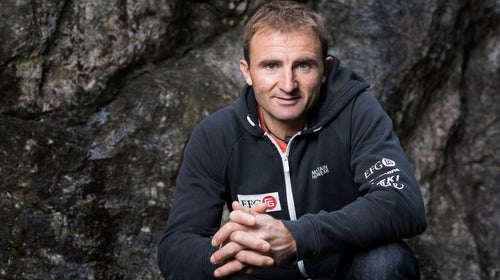Following the news that Ueli Steck, one of the world’s most formidable alpinists, lost his life on Sunday while climbing in Nepal, the entire mountaineering community was in mourning. While a number of ambassadors of the sport voiced their gratitude for the ways in which the Swiss Machine had influenced their lives and careers, the news of Steck’s death also came as a sobering reminder of the inherent dangers in elite-level mountaineering; if it could happen to someone as experienced and meticulous as Steck, it could happen to anyone. As Alex Honnold put it, “There’s always a degree of randomness involved.”
The sentiment was echoed in an interview with Reinhold Messner, who spoke to Alexandra Kohler for the Swiss newspaper in the wake of Steck’s death. (The interview has been translated from German.) Among numerous other achievements, Messner, 72, is known for being the first person to summit Everest without supplemental oxygen, as well as being the first to climb all fourteen 8,000-meter peaks.
NZZ: Mr. Messner, what went through your mind when you first heard about Ueli Steck’s death?
MESSNER: It came as a surprise to me, to be honest. I had not expected that, at age 40 and with his enormous level of mountaineering experience, he would fall at this point in his career. He was someone who knew exactly what he was doing.
Ueli Steck’s fall occurred on Mount Nuptse, near Everest, an area that you are familiar with. Nuptse wouldn’t appear to be too difficult an undertaking for an alpinist with Ueli Steck’s experience level. How would you assess the difficulty of the climb?
He was apparently looking to ascend Nuptse via the mountain’s north face, which is a route that should not be underestimated. That said, it’s not entirely clear to me why he took sight of Nuptse in the first place. He had previously announced that he was looking to attempt a route from Everest to Lhotse, for which he could have acclimatized on Everest. The only explanation I can think of is that he was looking to attempt the so-called “horseshoe”: Summiting Nupste, Lhoste, and Everest in the same tour. It’s a route that poses a significant mountaineering challenge. Many alpinists dream of accomplishing it.
Steck didn’t announce that the horseshoe was his intention?
No. All of us tend to proclaim more modest intentions at the outset, so that when we succeed [in achieving something more ambitious] we can subsequently announce our success. The horseshoe is extremely difficult; so far nobody has done it. But if anyone was capable of doing it, it would have been Ueli Steck.
Ueli Steck was a climber who tested boundaries and took enormous risks. Do you think that he went too far?
It’s not a question of making the right or wrong decision. It’s a question of whether a climb is possible or not possible. And Ueli Steck was someone who made things possible that were not possible before. In my day, ten hours was a fast ascent of the Eiger north face. Two hours and 23 minutes [Steck’s current speed record for the climb] was absolutely unfathomable at the time. Steck always had bold aspirations and was constantly evolving, for which I admired him. However, I was never that taken by his speed-climbing pursuits.
Why?
To me, it’s just not that important whether someone climbs the Eigerwand in ten hours or in three. I was much more impressed, for instance, that Steck managed to climb all 82 4,000-meter peaks in the Alps in a single summer. In the past 15 years, his influence on the sport has been essential.
You once said that a good alpinist has to be strong and fast in order to have an increased chance of survival. Do you think that Steck’s example challenges that theory, since he wasn’t merely fast but extremely fast, and so may have significantly increased the risk?
Anyone who ever witnessed Ueli Steck flying up the Eigerwand would know that he was always in control of his actions. He was always moving with immense precision and a sense of safety. Still, an element of risk will always remain. If a large rock falls from above and hits you on the Eigerwand, you are going to fall and you are going to die. There’s a basic rule, however: one should only attempt what one is capable of. That means that one should always stay a little inside of one’s own personal limit. Only the climber knows where that limit lies. So, when it comes to the risks that others decide to take, one shouldn’t pass judgment.
How challenging is it to be an elite alpinist today when all the big mountains have been climbed and all the north faces have been exhausted? These days, do elite alpinists need to seek out life-threatening projects to receive any attention?
That’s true to the extent that there used to be fewer very good climbers, compared with today. It was a bit easier to stand out. These days, the list of professional climbers is long. On the other hand, traveling is easier now than it used to be, and it’s more affordable. For a lot of people, it’s become feasible to fly to the Himalayas. There are also far more sponsors in alpinism and mountain sports today, so there’s more money around. It’s true, however, that to push the boundaries today requires doing one of three things: your climb needs to be either harder, more dangerous, or more exposed. The more experience you have, the more you can push those boundaries. Ueli Steck, I’m absolutely certain, had a very strong inner drive to keep pushing. He set very high standards for himself.
Translated to English by Martin Fritz Huber.�������ԹϺ��� �ٳ����Neue Zürcher for granting permission to republish.


